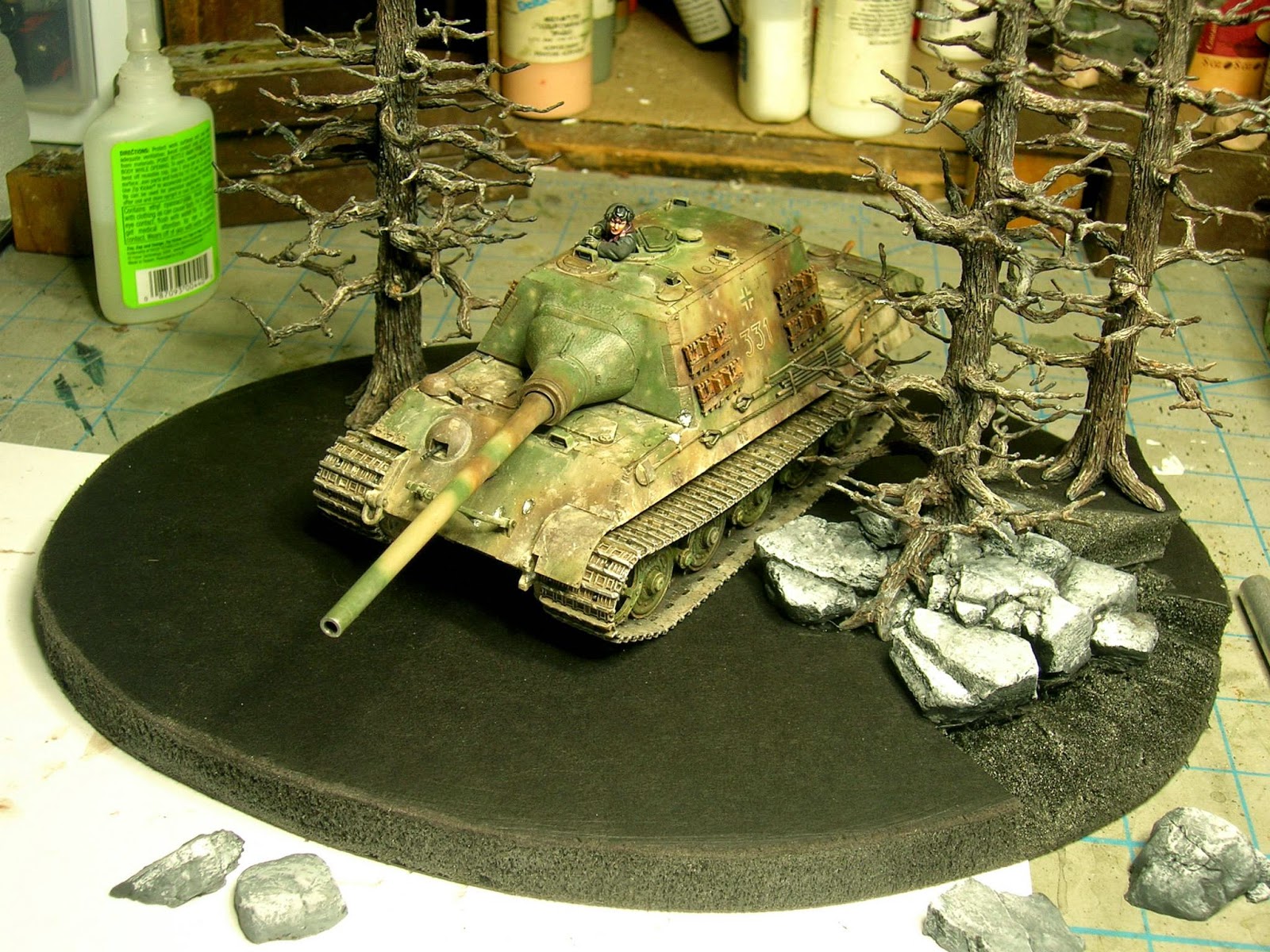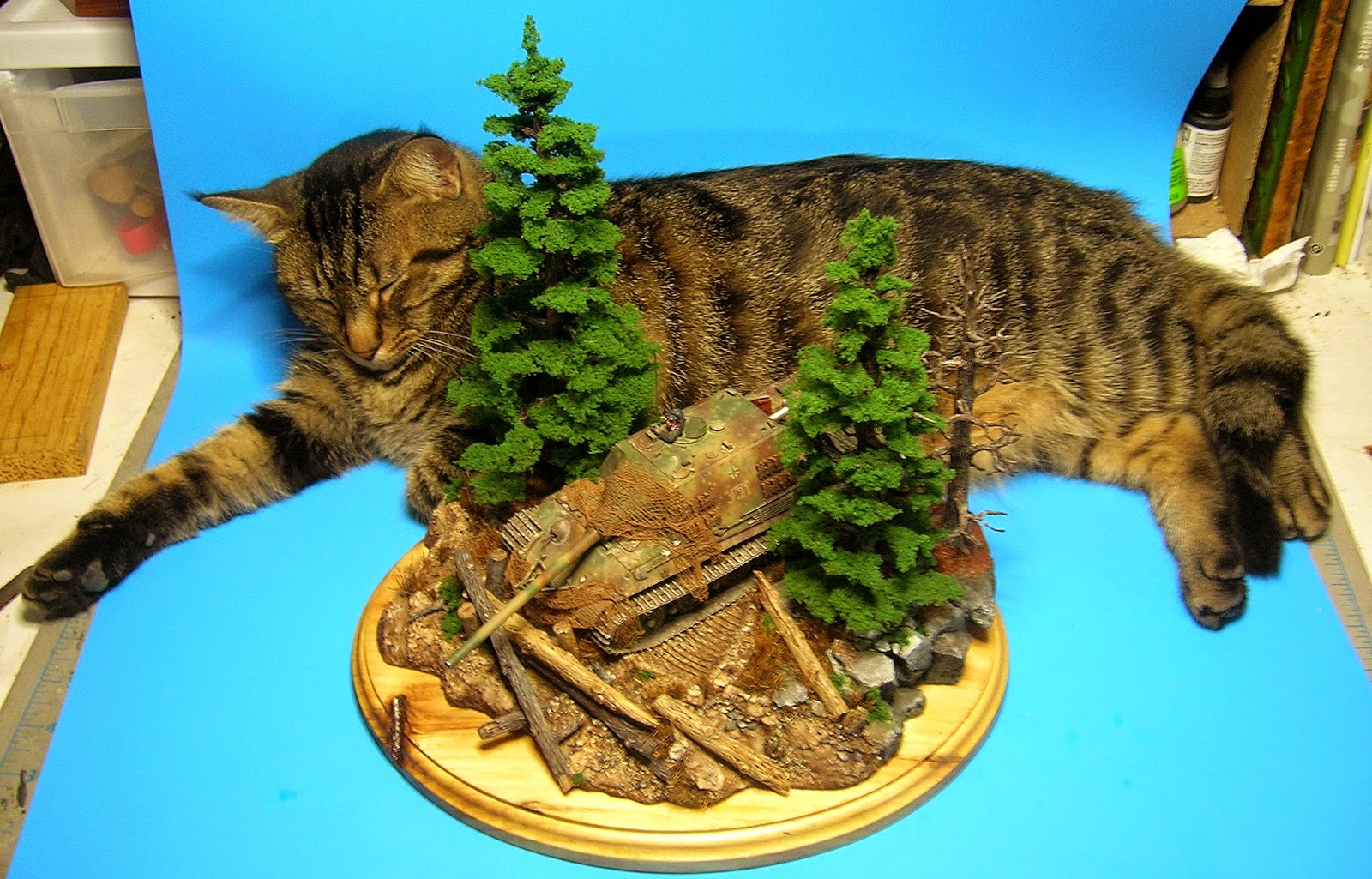Overview. This is Tamiya's 1/48th scale Jagdtiger, item 32569. I'm making Hunting Tiger 331 for a diorama of her the day before her capture, in her last action as part of Kamfgruppe Goggerle of schwere Panzerjager-Abteilung 653. I visited this vehicle many times over the years when she was displayed at the Aberdeen Proving Grounds in Maryland, USA. She is an old friend. This allowed me to use my own photos for reference.
Battle damage made by drilling holes in the plastic then detailing with Elmer's Wood Filler.
Photo etch grille covers from Eduard's King Tiger Mid. Production set #28 048. They are a little too narrow for this kit, so some filling of the grill openings was needed. Elmer's was used for this. The openings were then painted dark brown before the grill covers were attached.
All of the white colored parts were made from Evergreen plastic.
Tow hooks drilled out with a pin vise then a piece of brass rod added to hold it in place while still allowing it to move.
Rear View
Engine deck showing scratch-built detail pieces. The engine access hatch handle is a piece of thin gauge wire.
Working on her running gear.
 Running gear base painted and assembled.
Running gear base painted and assembled.Adding a disk made from aluminum tubing to the end of the gun barrel.
Periscopes made from clear plastic from a CD case.
White styrene bases to mount the periscopes to the underside of the Jagdtiger's fighting compartment's roof.
Using light gray paint to represent the raised aperture around each lens.
Finishing with overall dark gray paint.
The periscopes installed.
Base coated with Modelmaster Chocolate Brown mixed with Delta Ceramcoat Burnt Umber and Tamiya Flat Base. Modelmaster is used because it adheres well to plastic. Delta Ceramcoat Burnt Umber added because there was not enough paint remaining in the Modelmaster bottle. Tamiya Flat base added to kill the Modelmaster shine.
Delta Ceramcoat Forest Green stippled/drybrushed over the brown base.
I use old cut down cheap brushes for this.
Delta Ceamcoat Country Tan added. In the background are the brushes I use to replicate a sprayed on look.
Delta Ceramcoat Cinnamon carefully brushed on as exposed primer. A dark brown wash over the primer to darken it.
Spare track attached. Delta Ceramcoat Country Tan drybrushed on with my smallest modified brush.
Thinned Delta Ceramcoat Country Tan stippled on a a base for dirt/dust.

Decals added and the remaining dots drybrushed on. Delta Ceramcoat Burnt Umber used for the brown dots. Washes of brown, green, and tan added to help blending.
More refinement to the finish. More drybrushing. Green and yellow washes over the Country Tan to appear as Dunkel Gelb. Brown washes over the Forest Green to appear as Olive Grun. Dark orange washes over the brown to help blend it's edges.
A black wash applied to all panel lines.
Delta Ceramcoat Autumn Brown (as rust) applied with a detail brush randomly to raised edges.
Delta Ceramcoat Sandstone added to some areas of the dust layer to lighten it..
Delta Ceramcoat Medium Brown (my best guess of the color as it's name has been worn off of the bottle) added as a wash to darken some areas of the dust layer.
...
Making
spent ammo rounds. Using a hobby knife to cut through aluminum tubing
by rotating it around the tube, applying gentle pressure mimicking a
tubing cutter. A tubing cutter would leave transverse scratches.
The rounds are glued to .010 thou sheet plastic bases. Theses are trimmed and sanded, then drilled in the center with a #68 drill bit.
...
I'm revising the idea for the diorama.
Now she will be in a firing position during the day before her capture. Here while she and her two wing men destroyed 25 US M4's and M10s, she received her battle damage.
She will be positioned between two pine trees behind a damaged log barrier.
The base I chose has a knot on it's edge. I chose it for this reason. It will represent incoming fire.
I spend considerable time on composition.
Determining layout.
Making pine trees from wooden dowels for trunks and twisted wire for branches.
Using Super Sculpey to texture the logs for a barrier.
Using the same technique to make bark for the trees.
Now determining elevation. The groundwork will slope upwards from front to back.
Using Sculpey Firm to sculpt rocks. Using real rocks as tools for applying texture.
Then the accident. A shelf collapsed.
Refining composition and sculpting additional logs. The pink logs are from Super Sculpey. The gray logs are also form Super Sculpey but with Charcoal Gray acrylic paint added.
The paint makes the clay a little softer. When baked the clay is just as hard and offers the same resistance when sawed.
Adding the gray eliminated the translucent quality of the Super Sculpey making it easier to see and sculpt finer detail.
Painting with acrylics, dry brushing and washes.
Finished painting.
Last check of composition.
Glueing the painted elements to a piece of 1/2 inch/12.5mm foamboard.
Cutting out the elevations.
Additional elements added. More foamboard cut away.
Closeup
"Der treue Husar" (The Faithful Hussar).
The morning of 22 March 1945 Neustadt an der Weinstrasse. Kampfgruppe Göggler (3/Pz.Jg.Abt653) exchanges fire with Task Force Cherry (10th Armored Division). Lt. Kasper Göggler positioned his Jagdtiger #331 along with #234, and #323 on a wooded hill (my assumption based on maps and photos of the area) overlooking the northern approach roads into the town. No losses to the Jagdtigers though #331 and #323 suffer ten non penetrating hits between them. Sources vary with Task Force Cherry suffering between 2 to 28 M4s (76mm) and/or M10s knocked out. The battle ends when smoke is used to blind the German position.
KG Göggler withdraws into the town defending it's center the next day. JTs #331 and #323 are captured after they break down. Lt. Göggler and his crew along with JT # 234 successfully retreat. JT #331 is recovered by the Americans and sent to Aberdeen Proving Grounds, Maryland, USA where it is displayed for many decades. Now she resides in Fort Benning GA , USA.
Cheese cloth is used for the netting. Painted brown before attaching it to the vehicle. Water and diluted white glue used to shape and secure it.
Pre painted hemp rope for the weeds. Several shades of tan, brown and green were used.
I deliberately chose a wooden base with imperfections. The knot suggests damage from incoming fire. Brown, red brown, and rust colored paint was used to enhance the grain. Two coats of clear satin polyurethane were brushed onto the base using a foam applicator to seal it and deepen it's tone. Light sanding between the coats.
Garfunkel thinks it's finished.
Garfunkel was wrong.
A friend gave me a small glass display case. The old dio. was too tall for it. Shortening the trees threw off the balance, so I made a new dio. for #331.
Construction time was considerably shortened by recycling the diorama's components.
...
...
...
...
...
...
...





















































.jpg)










